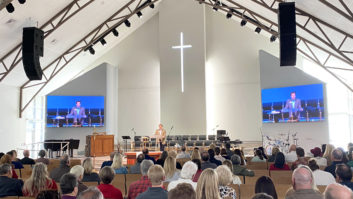After a look at the factors holding back adoption of audio networking, and a follow up piece on the reasons for wider implementation, David Davies concludes this feature by considering what impact convergence would have and the applications where IP could grow.
It stands to reason that increased convergence among networking technologies – such as that heralded by AES67 – will make integrators and end users feel more confident about investing. Commercial realities, however, mean that this is far from straightforward, so for the foreseeable future manufacturers will be obliged to accommodate as many different networking techniques as is practically possible.
“We support multiple networking protocols because each has their strengths in certain situations,” says Erik Tarkiainen, vice president of global marketing, at Harman Professional. “If the market converges on one or two, that’s fine with us, but we also have the R&D resources to fully support multiple protocols, which to this point has been what our customers have asked of us.”
Specific application-oriented requirements relating to factors including latency and synchronisation are also regarded as a further challenge to convergence. Additionally, says Frank Frederiksen, MD of Barix, standardisation “normally means increased overheads and complexity on top of the basic protocol (TCP/IP); on top of that it often also means increased cost in terms of licences or even proprietary components. Many applications do not need the added benefit that comes with these standards, and therefore will not carry the cost of implementing them either. On the other hand the most basic protocol cannot satisfy all the requirements in any applications and all markets either.”
Despite these issues and the relative youth of the AoIP market, “consolidation can be expected, and thereby also a reduced number of network technologies. However, reaching only a couple is not within close reach.”
Growth applications
As Justin O’Connor, product manager, audio products for Biamp Systems very reasonably observes: “There are certain applications where networked solutions provide tremendous technical and cost benefits, as well as applications in which networked audio is more of a ‘nice to have’.”
Nonetheless, he goes on to cite the corporate environment, transportation, railway facilities and healthcare centres as among those applications in which networked architecture is “best served” – in short, those where multiple buildings may be involved and there is a need to ensure superlative communications and connectivity between them. Thinking along similar lines, Trevor Donarski – product line manager, software and tools for Bose Professional suggests that “houses of worship are starting to realise the power of networked audio for distribution to multiple rooms, sites and cameras”.
On behalf of Harman, Tarkiainen points to “solid growth in sales of networked systems and networkable technologies in the mid-tier and retail sectors, and these systems are typically deployed in education, corporate, government and retail/hospitality. Each sector has different cost/benefit/use-case expectations from networked audio systems, and for each we try to provide a tailored solution.”
Such case studies that can cogently and coherently explain the benefits of networked audio will undoubtedly help more integrators and consultants to join the fray. But the fact that there is still a shortfall in adoption should give cause for concern after nearly a decade of increasingly fevered debate. Alongside talking up these new technologies, it may be that there are ample grounds for a concerted focus on a rather more old-school technique – namely that of ‘outreach’ in the form of seminars, roadshows and workshops at leading trade shows such as ISE. Because without this kind of sustained connection between vendors and customers, audio networking will never live up its full potential.
Biamp audio solutions
Harman Professional
Barix IP solutions
Bose Professional IP systems







